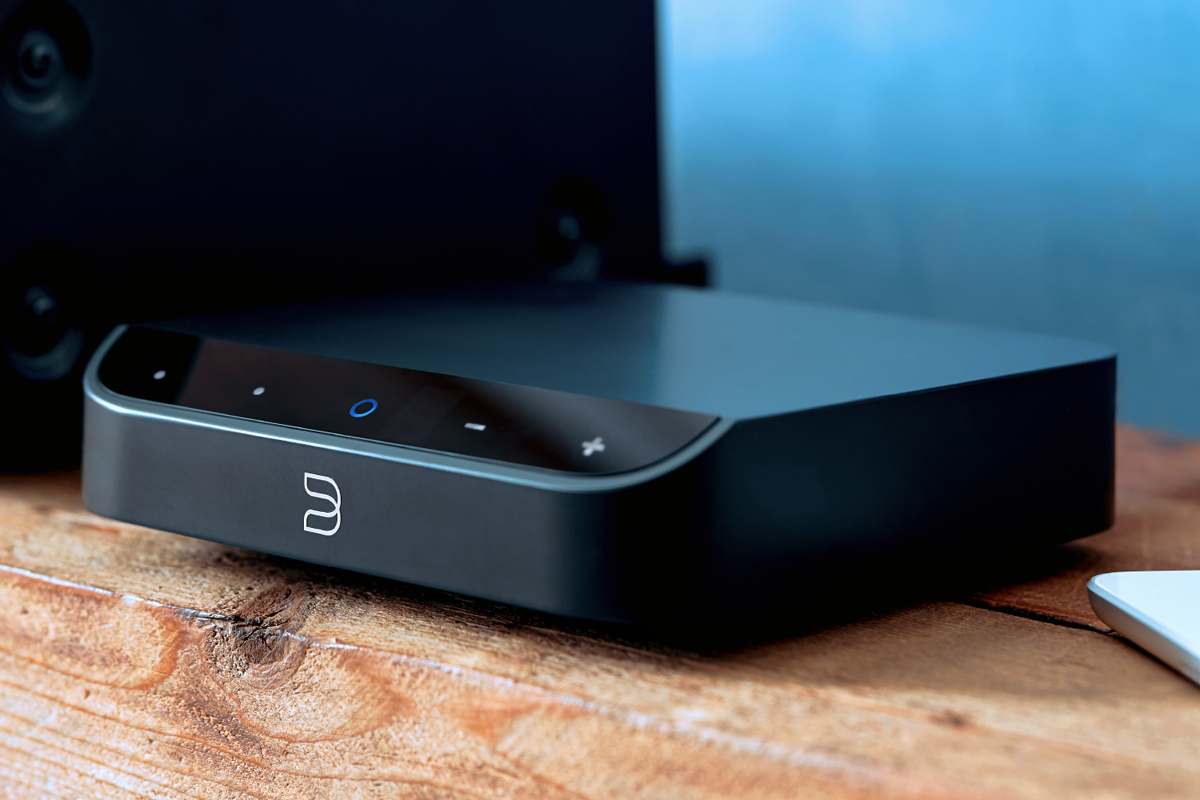 Canada’s Bluesound has made a name for itself with its highly regarded music-streaming products. In July 2023, I reviewed Bluesound’s Powernode Edge streaming integrated amplifier for Simplifi and was impressed by its sound and design. Bluesound has recently introduced three new music streaming devices: the Node Icon reference music streamer ($999, all prices USD), the Node performance music streamer ($549), and the Node Nano wireless music streamer ($299), the subject of this review. As the names suggest, each model offers different levels of functionality and performance, with the Nano being the most basic.
Canada’s Bluesound has made a name for itself with its highly regarded music-streaming products. In July 2023, I reviewed Bluesound’s Powernode Edge streaming integrated amplifier for Simplifi and was impressed by its sound and design. Bluesound has recently introduced three new music streaming devices: the Node Icon reference music streamer ($999, all prices USD), the Node performance music streamer ($549), and the Node Nano wireless music streamer ($299), the subject of this review. As the names suggest, each model offers different levels of functionality and performance, with the Nano being the most basic.
Inner beauty, outer connectivity
Measuring 1.4″H × 5.6″W × 5.6″D, the Nano is compact and stylish, and can be set on a shelf or hung on a wall, so it will fit with nearly any room setup. There is a rubber cover on the bottom of the unit that keeps the Nano from sliding around. Remove the cover and you’ll find two keyhole slots that can be used as a guide for drilling mounting holes in a wall. Mounting screws are not included.
If beauty is what’s inside, the Nano is a looker. It employs the same ESS ES9039Q2M Sabre DAC used in Bluesound’s new performance and reference models, though the Icon has two of these chips in a dual-mono configuration. As well, the Nano features a quad-core 1.8GHz ARM Cortex A53 processor, the same one found in the performance streamer. The Nano is capable of playing a variety of sound files in resolutions up to 24-bit/192kHz, including AIFF, FLAC, WAV, and MQA. For wireless connectivity, the Nano features dual-band Wi-Fi 5 and bidirectional Bluetooth.
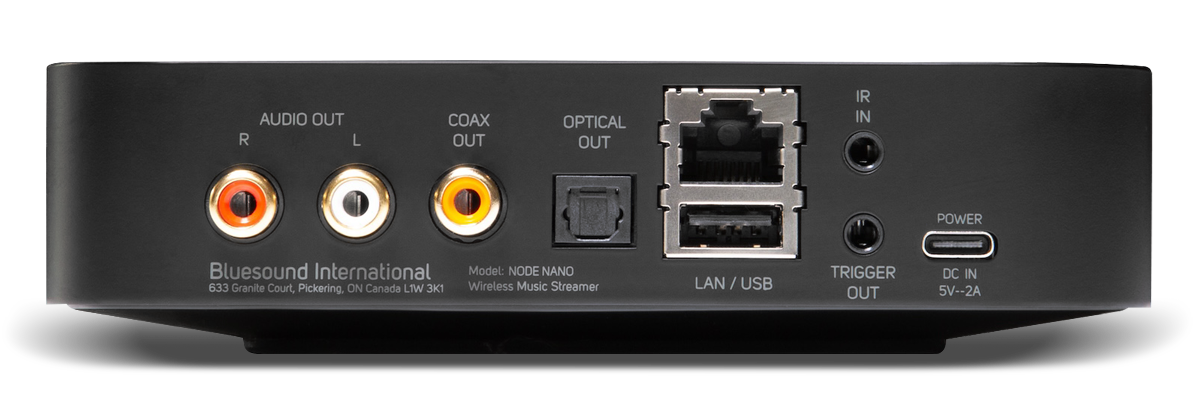
On the back panel, you’ll find a pair of line-level analog outputs (RCA), a digital S/PDIF out (RCA), and an optical S/PDIF out (TosLink). There’s also a USB-A port that can be used to output digital audio to a USB DAC, or to connect an external drive loaded with music files. If you opt for the coaxial, optical, or USB output, you will bypass the Nano’s internal DAC. You’ll also find an ethernet port to hardwire directly to a home network, along with a 3.5mm IR input and a 3.5mm 12V trigger output.
One nice feature is the USB-C power cable partnered with the compatible power adapter. Bluesound supplies a cable with the Nano, but if you need a longer cable, it’s easy to purchase a replacement of the necessary length. This is a simple feature, but a valuable one, as every room is different, and one power cord rarely fits all.
Setup
In the box, along with the Nano, you’ll find a stereo RCA-to-RCA cable, an ethernet cable, a USB 5V power adaptor with four international plugs, and a USB-C power cable.
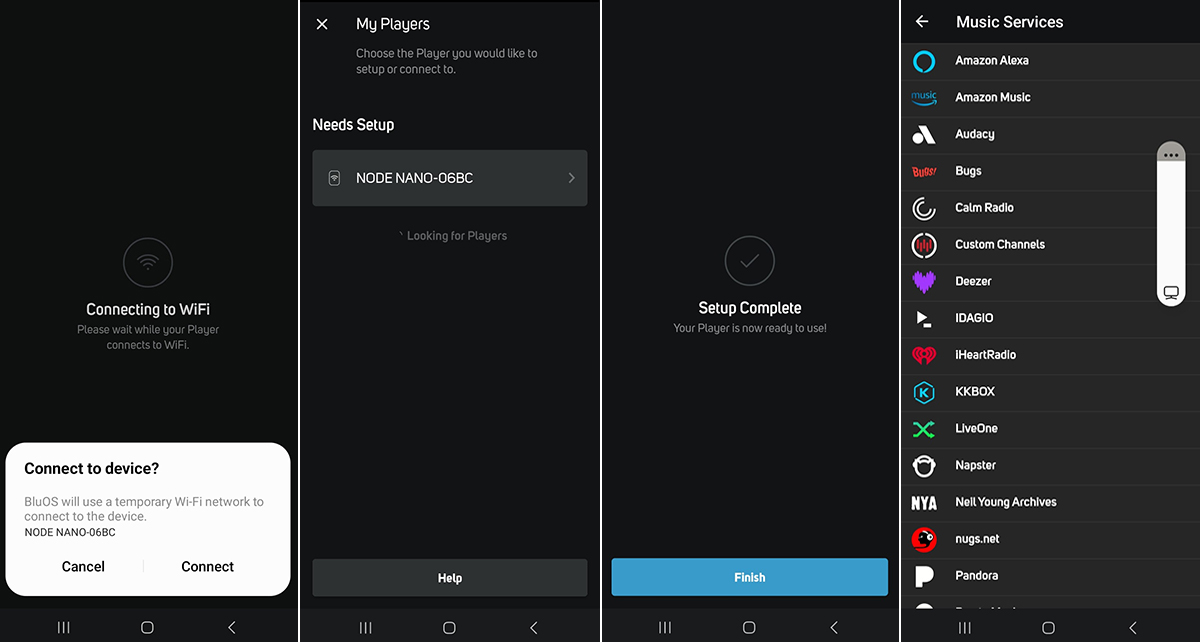
The Nano is easy to set up, particularly if you’ve previously used the free BluOS Controller app, which is available for Android, iOS, Windows, and macOS. Download the app to a smartphone, tablet, or personal computer, open BluOS, and follow the “Add a Player” wizard. Connect the Nano to your audio system via analog RCA, optical, coaxial, or USB. Plug in the streamer’s power source and soon the front-central LED will flash green, indicating that it’s ready to connect. Open the BluOS app and follow the prompts to add a network. The process takes about five minutes.
The BluOS Control app comes with Radio Paradise and TuneIn Radio preinstalled. BluOS also has integrated support for over 20 subscription-based music services, including Amazon Music Unlimited, Deezer, Napster, Qobuz, SiriusXM, and Tidal. The Node Nano is Roon Ready and also supports Apple AirPlay 2, Spotify Connect, and Tidal Connect.
On the Nano’s sloping front panel are five touch LEDs: two for adjusting volume, one for pausing and resuming playback, and two for accessing preset playlists and web radio stations that you’ve designated as favorites in the BluOS Controller app.
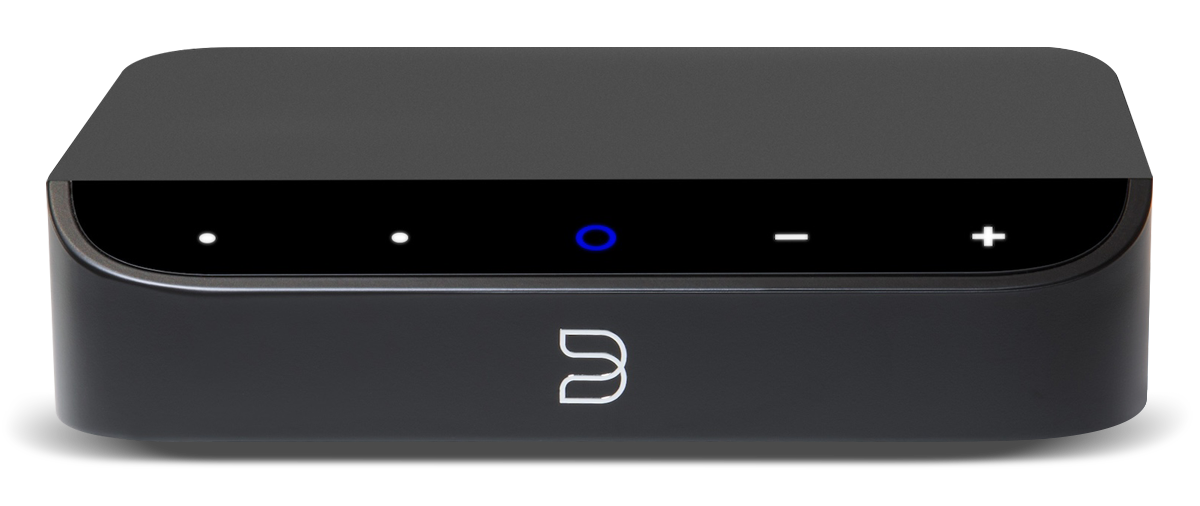
If you’re looking to create a multiroom music system, the Node Nano can be grouped with other Bluesound players. This allows you to control your music in every room from your phone, tablet, or desktop, using the BluOS app. You can also use the BluOS app to cue up music from your favorite streaming service or from an external drive connected to the Nano’s USB port.
Review system
I auditioned the Node Nano with Yamaha’s A-S801 integrated amplifier ($899.95), connected to a pair of Human Speakers Model 81s ($678 per pair). I used Bluesound’s supplied RCA cables and connected them to the Nano’s analog-out jacks. The speakers were placed on 26″-high homemade stands and connected to the A-S801 with Better Cables Premium Anniversary Edition speaker cables (3m, terminated in banana plugs). My listening room is 14′W × 16′D. The speakers were 7′ apart, 28″ from the front wall and 40″ from the side walls, toed in slightly to my listening position 7′ away. For this review, I used the BluOS app to stream audio from the Qobuz and Tidal music services and listened to music at a variety of resolutions.
Music time
Blue Öyster Cult’s 1981 release Fire of Unknown Origin (24/96 FLAC, Sony Legacy / Tidal) was first up. The title track leads off the album, and while listening, I was struck by how well-balanced the portrayal of the instruments was. The Nano did a great job bringing out Joe Bouchard’s funk-like bass lines against his brother Albert’s tight drumbeats. At the song’s end, Allen Lanier’s keyboards sounded like water droplets cascading down a hillside in some science-fiction landscape. Each note was clear and distinct. I’ve heard this song dozens of times but never really noticed the intricacy of this outro.
Jade Warrior’s 2008 album Now (16/44.1 FLAC, WindWeaver Music / Tidal) has become one of my references, as it features a wide range of instruments, excellent music, and a gorgeously enveloping soundstage. The lilting “Talisman” comes to life through Dave Sturt’s acoustic bass, Glyn Havard’s sleepy vocals, and Jon Field’s flute twirls. The Nano provided excellent dimension and spacing as well as clear articulation of the acoustic guitar chords that punctuate the rhythm. Few digital recordings match Now’s openness and analog-like warmth, and the Nano made a very good album sound very good.
Later in the review period, I connected the Nano to the USB input of the Yamaha A-S801 and replayed the previous two tracks, reasoning that using the DAC in my amplifier rather than the one in the Nano would help me get a handle on the quality of the Nano’s digital section. And it did. The music I heard via the Nano’s analog outputs appeared on a larger soundstage. There was more air around the instruments, and each instrument was better defined. For the rest of my listening, I used the Nano’s analog outputs.
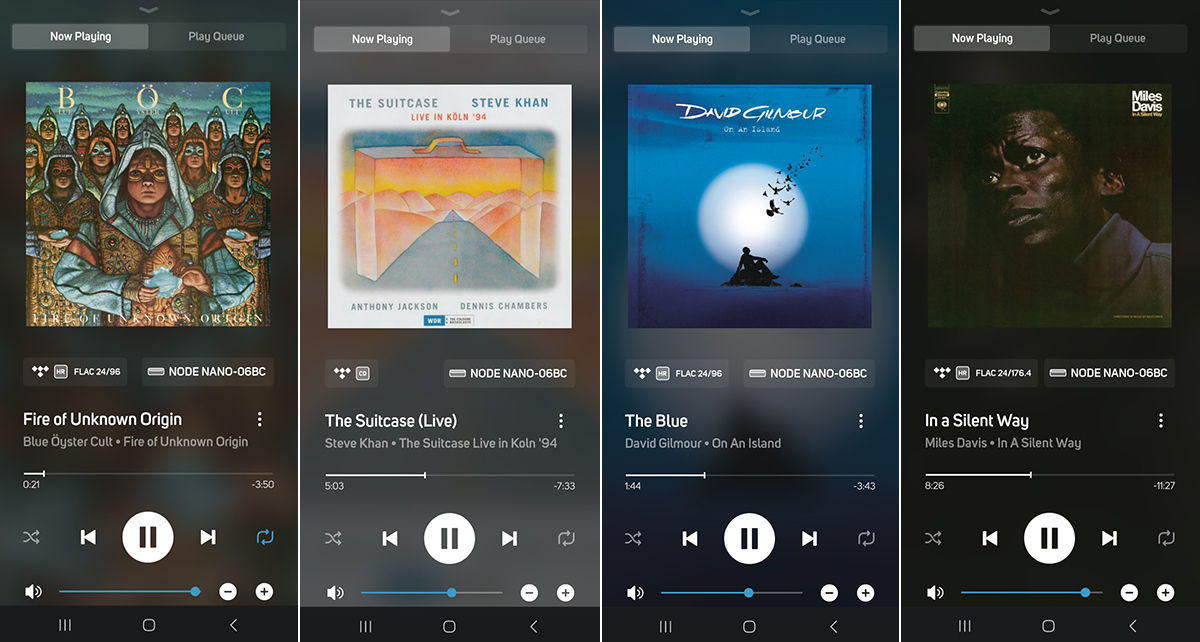
Listening to the title track of jazz guitarist Steve Khan’s The Suitcase (16/44.1 FLAC, WDR / Tidal), a live recording from 1994 with Anthony Jackson on bass and Dennis Chambers on drums, was a treat. Khan’s creamy guitar tone underlies Chambers’s propulsive drumming. The bell on the ride cymbal rang true, and the low buzz of Jackson’s bass sounded at times like Tibetan throat singers or the very lowest piano keys.
David Gilmour’s On An Island (24/96 FLAC, Columbia / Tidal) is a generally breezy affair, with some guitar histrionics thrown in for good measure. Tunes such as the title track and “The Blue” are lush, dreamy numbers with superb background vocals from Rick Wright, Graham Nash, and David Crosby. Through the Nano, I could hear the three vocalists breathe as they expelled the last syllables of each phrase—a wonderful thing. It was as if the words had been picked up and carried through the air into my ears, allowed to float and sustain like a lingering summer cloud.
The Eagles’ Hotel California (16/44.1 FLAC, Rhino-Elektra / Qobuz) is loaded with radio staples, but I favor the album’s two least-publicized tracks: “Pretty Maids All in a Row” and “Try and Love Again,” sung by Joe Walsh and Randy Meisner, respectively. From the quiet opening of “Maids,” with its half-time beat and Beach Boys–esque harmonies, the Nano perked up my ears immediately. It presented a broad soundstage and gave surprising force to the stairstep-like moment when the strings enter, punctuated by Don Henley’s drums. The outro of “Try and Love Again” caught my ear too, particularly when Joe Walsh’s old-school Gretsch guitar has a wonderful moment of its own. I could clearly hear the instrument’s pedigree as the arpeggios flowed under Walsh’s pick.
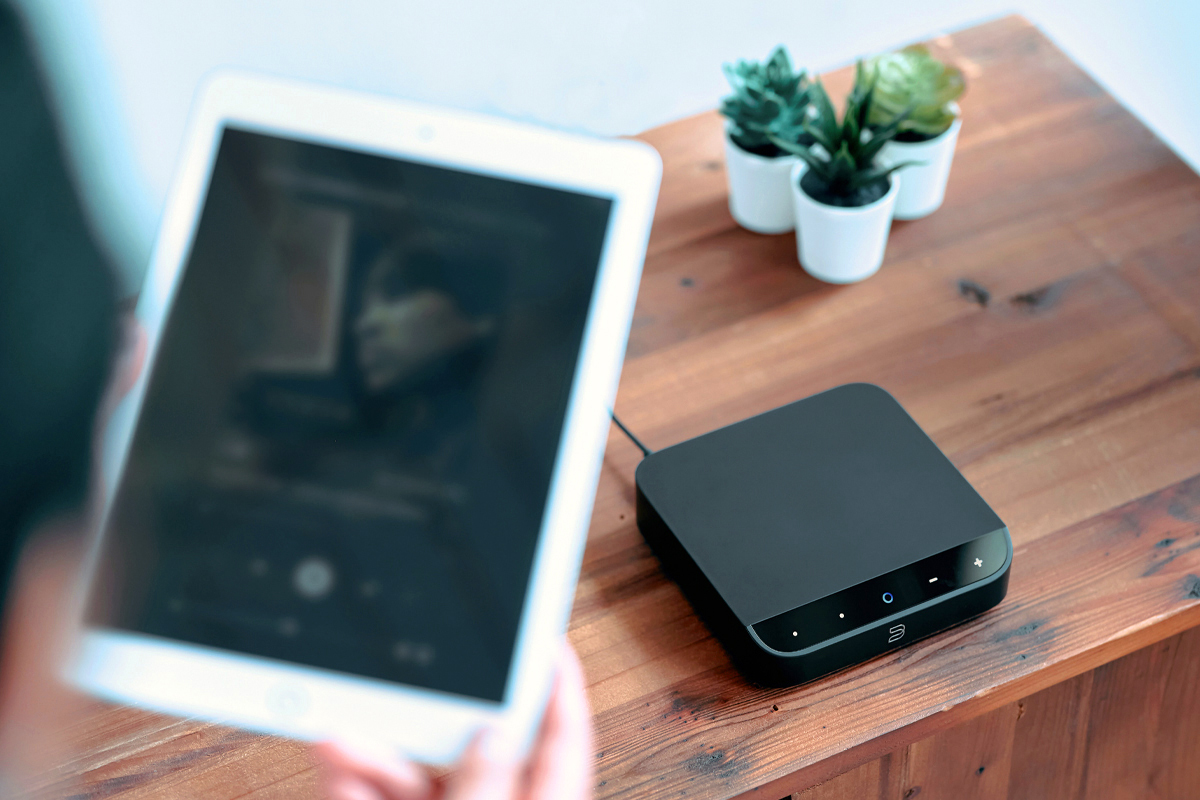
Benjamin Franklin is known for many things: he was one of the founding fathers of the United States, the publisher of Poor Richard’s Almanack, and an influential politician. He was also a dedicated musician and composer, and the inventor of the armonica, an instrument employing tuned glass bowls arranged on a spindle and controlled by a pedal. The armonica found favor with Mozart and Beethoven, both of whom composed works for the instrument. Pop singer Linda Ronstadt is a champion of the instrument and co-producer of Cristal: Glass Music Through the Ages (16/44.1 FLAC, Sony BMG / Qobuz). The album features Dennis James on armonica covering music from the 17th through 20th centuries. The armonica produces mesmerizing, almost otherworldly sounds. It’s delicate, filigreed, and translucent, as if light was somehow captured in a note. Those qualities shone through as the Nano brought Mozart’s Adagio in C Major, K. 356, among other pieces, to bloom with radiance and grace.
The title track of Miles Davis’s In a Silent Way (24/176.4 FLAC, Columbia Legacy / Tidal) sparkled, too. This deceptively simple tune is one of the horn man’s greatest arrangements. I enjoyed how the Nano put “air” around John McLaughlin’s gentle guitar lines, spaced within the celestial keyboard flow of Joe Zawinul, Herbie Hancock, and Chick Corea, and Davis’s muted horn. As well, the Nano’s dead-silent operation made the “silent way” even more so.
Final thoughts
I can see the Nano appealing to many audio enthusiasts. If you want to add streaming capability to a legacy music system, the Nano offers a cost-effective way to do that. Many music systems, such as the Q Acoustics M40 HD system I reviewed in July, have Bluetooth connectivity so that you can stream music wirelessly from a smart device. The Nano will provide a significant upgrade in convenience and performance compared to streaming via Bluetooth. With its high-performance DAC, solid software platform with integrated support for many streaming services, and multi-room capabilities, the Node Nano is a standout choice for anyone looking to dive into the world of wireless music streaming. You might not want to come up for air again.
. . . Todd Whitesel
Associated Equipment
- Loudspeakers: Human Speakers Model 81
- Integrated amplifier: Yamaha A-S801
- Speaker cables: Better Cables Premium Anniversary Edition (3m)
- Control device: Samsung Galaxy A32 5G smartphone
- Network: Netgear C7000v2
Bluesound Node Nano streamer
Price: $299
Warranty: One year, parts and labor
Bluesound
633 Granite Court
Pickering, Ontario L1W 3K1
Canada
Phone: 1-855-531-4666
Fax: (905) 831-6936
E-mail:
Website: www.bluesound.com



